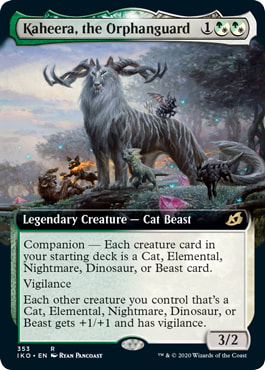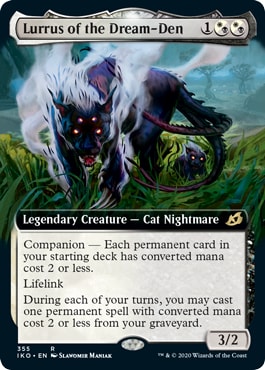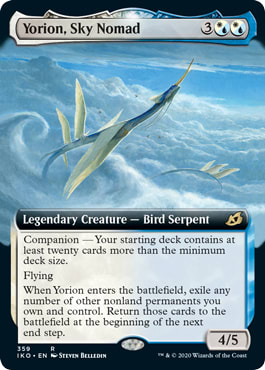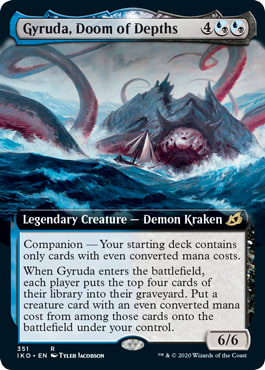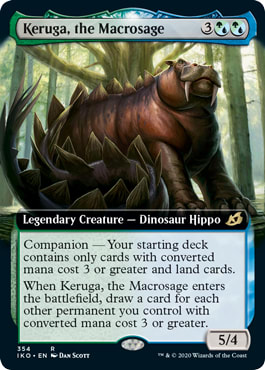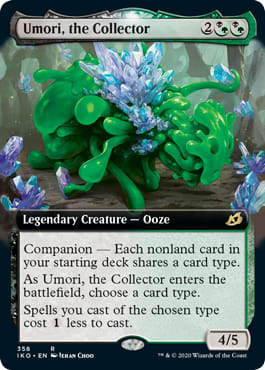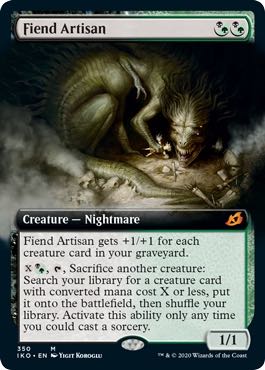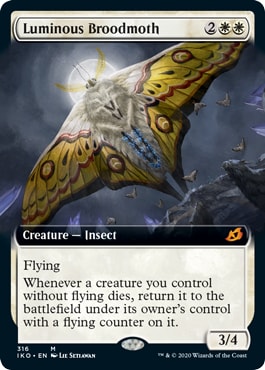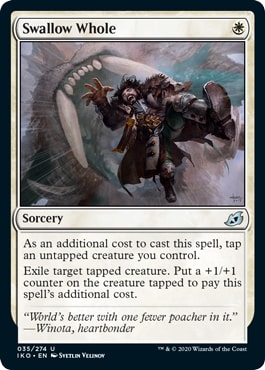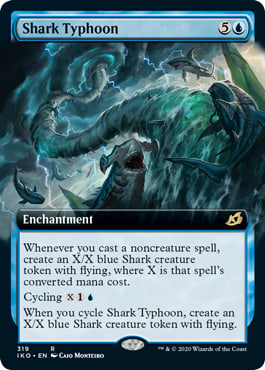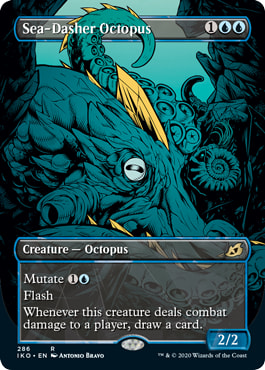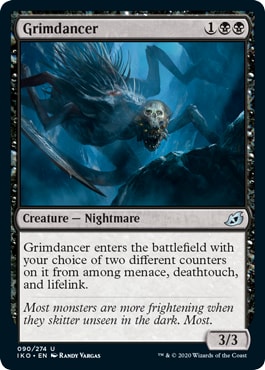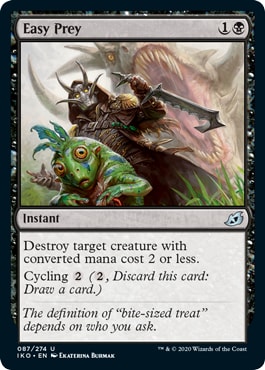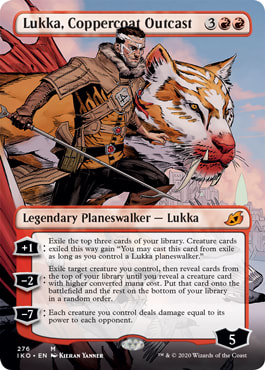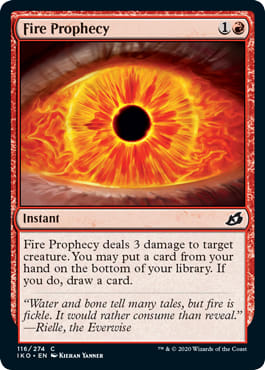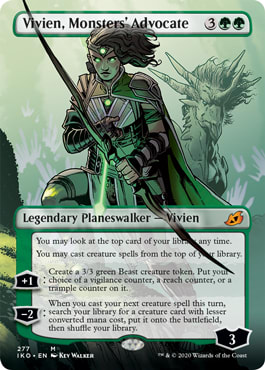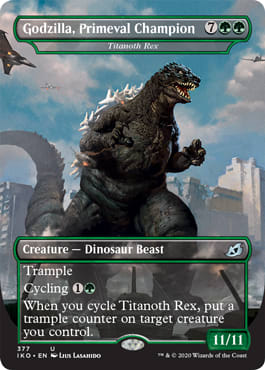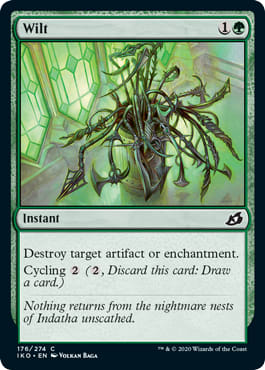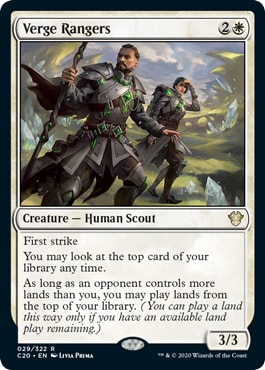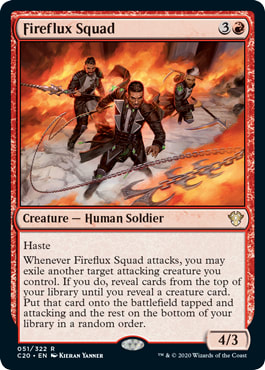With Core Set 2021 already being out and impacting Constructed formats, Ikoria: Lair of Behemoths is quite old news at this point; but, I still have words to say about Ikoria in Cube, so let's jump in and distract ourselves from the hellscape that is 2020.
Usually I'd put a disclaimer about how my reviews are coming from actual experience and not just outsourcing to other formats. That disclaimer still applies, but my weekly cubing sessions have been curtailed from Covid-19. Even though Ikoria came out a while ago, I'm just not able to get the sheer numbers of drafts that I'd been able to in the pre-Covid time. Because of this, I've been drafting other Cubes that don't test things as aggressively as I usually do (not that it's a bad thing) and I'm not cubing as often as I usually do. Despite hitting mythic this month in Constructed for 2 months (but not holding top 1200) in a row, I think I'm just not having fun playing Magic lately, but the show must go on.
Skip to:
Multicolored & Lands
Since changing my article organization to doing them by color, I've tended to lay things out by approximate section - ![]()
![]()
![]()
![]()
![]() and then multicolored and the rest at the end since people generally tend to care more about Mono-Color sections for Cube. But, I might as well get the 3/3 Call of the Herd token out of the way - Companions.
and then multicolored and the rest at the end since people generally tend to care more about Mono-Color sections for Cube. But, I might as well get the 3/3 Call of the Herd token out of the way - Companions.
Ironically, like with how we're self-quarantining in the age of Covid-19, we can shelter ourselves from the bad effects of the outside world and not include them in our Cubes.
Sometime after Ikoria arrived on Arena, there were tweets by @17lands compiling the winrates both before and after the companions got nerfed. Being a (mostly) non-sanctioned format, you do have the option of running companions with the pre-nerf companion rules, but if you do so, for the love of Thassa and Heliod, please make it 100% crystal clear to your drafters that you're doing so, either by explaining it before the draft in a clear manner or slipping a piece of paper in the sleeve (for whenever we're able to Cube IRL, hahaha).
Cube, being part Limited and part Constructed, has some analogues to retail Limited but isn't an exact match. Some companions have remarkably easy constraints to hit in Cube, Lutri being comically easy, even in a format that uses multiples of cards.
Kaheera, the Orphanguard and Zirda, the Dawnwaker only really require to play them in decks without creatures. Occasionally I'll see that kind of deck crop up unintentionally or as a stipulation, but these are some actual payoffs for doing that intentionally. Limiting planeswalkers makes this goal harder to achieve as planeswalkers generally act as both threat and card advantage engine.
Lurrus of the Dream-Den - An angel loses its wings whenever someone plays Grave Titan or Griselbrand in an aggro deck, since it stems from fear of cards like Jackal Pup being perceived as being bad topdecks in the lategame. What it doesn't take into account is getting to the late game is almost game over for the aggro deck anyway and cards like Griselbrand and Grave Titan are stone blanks in the early stages of the game (even if it feels more "acceptable" as a fail state, it really isn't.) Just don't do it, friends.
Playing Lurrus as a companion means that you generally have to put cards like planeswalkers and some curve-toppers like Goblin Rabblemaster in the sideboard and/or have to lean a bit harder on non-permanents to be curve toppers. The payoff is worth it in decks that can play it. Despite the late game being almost game over, the fact that a Lurrus in the sideboard as a companion acts as a hedge while not rotting in your hand (and making your early game clock worse) has been solid thus far if that's something you're interested in for aggro decks. Conceivably, this could also work as a free card for combo decks that don't use mana flares as ways to increase mana since its kill spells are generally spells, but I've not really seen it happen.
Obosh, the Preypiercer is another companion for aggro decks that plays similarly to Lurrus but one that puts more pressure on getting your required 1-drops. If you've drafted and/or watched streams of John's Cultic Cube, you'll have noticed how streamlined giving more 1-drops to your aggro decks can make them. Since the beginning of time, 1-drops are the bread and butter of Cube aggro decks, and 2-drops are generally not that important (at least nowhere near as much as 1-drops.) Like Lurrus and cards like Nezumi Cutthroat, they tell you how to play them correctly. Do so and you will be rewarded.
Jegantha, the Wellspring - Similar to Obosh in being another aggro companion where you may need to make concessions during drafting, like having to jettison your Searing Blaze or Knight of the Holy Nimbus to play it. Even as just a legendary Colossapede with some mana producing flavor text, having the ability to play it at the top of the curve is very much worth it.
The other companions are still decent as companions, but moreso are worth looking into as standalone creatures as they're relatively pushed for their mana rates.
Yorion, Sky Nomad - essentially, you have to be a deck where you can't afford many "wasted" picks, so you'll be unable to use picks on non-basics and the margin of error is quite thin, and if you get it in pack 2 or 3, it's even harder. If you've drafted one of the greedy-rewarding conspiracies like Worldknit or Sovereign's Realm where you just take whatever, it's somewhat similar, but you have to be more careful that you can actually play the cards in your deck, so you usually have to be disciplined and only go in a color or two and not stray far from the deck path. Because of this, the margin of error can be very thin, but it's generally worth it, if it can be done.
Gyruda, Doom of Depths, Keruga, the Macrosage, and Umori, the Collector are pretty hard to make work in Cube as it's easy to make an aggro deck with just 1-drops and 3-drops, but not so much with control decks with only 2-drops, although it's certainly possible. With Umori, it's even harder to make work and if you get it pack 2 or 3, good luck.
Fiend Artisan highlights an issue that I've found with cards like Birthing Pod, where they shine in Constructed formats due to being able to play a playset of the card and due to being able to perfectly craft conditions to make it work.
Some cards, like Heirloom Blade, still tend to work exceptionally well in Cube, because of inherent support amongst existing creature types.
But generally, Birthing Pod always seemed to fall short in my Cube experience. Fiend Artisan plays much easier since it doesn't require a dedicated chain, but it's mainly as a cheap aggro creature that randomly gets larger in the later stages of the game via dead fodder and can act like a creature tutor for a curve topper. Generally, whenever I hear someone talk about Aristocrats decks, I find it usually isn't worth the effort - either in deck in construction or Cube design - but this isn't a card that's only good in those kinds of decks, like Zulaport Cutthroat.
It's a bit too low impact on resolution for midrange decks, and I've not had a chance to try Fiend Artisan yet, but my impressions of it have been good, even if it can only search at sorcery speed.
Triome cycle - it's been a running gag that I love to draft greedy multicolored decks from people not eating their veggies and not taking mana fixing lands highly enough. Somewhere along the line, the meme was attributed to my cat, Chrono, possibly because he's a polydactyl cat with a ton of extra toe beans - or because he's a sassy little tank who likes to cause trouble, like this:

Occasionally, I'll see lands from the aptly named "bad river" cycle to fetch duals, as that's really all that they're good for as they're just so glacially slow to search for duals. One thing I've liked with playing the triomes is how they can enable even weirder fetchland inclusions and how having a fetchland in your deck and one of the triomes tends to mean you've likely got Domain, which is great if you're a greedy monster who likes tagging people at 11pm that you Worldly Counseled for 5.
That said, three mana to cycle is a *lot* and usually cycling only really happened when flooding and in topdeck scenarios since the cost was so high. They're nowhere near as powerful as a lot of existing lands, including the underrated painland cycle (Adarkar Wastes, Battlefield Forge) but I would certainly not bat an eye if I saw one in a Cube pack and would likely just trainwreck my deck to take one because that's how Chrono rolls.
Crystal cycle - it takes a lot for a 3-mana rock to be worth playing in a Cube. Even with the ability to cycle, unlike the triome cycle, this isn't worth it.
Narset of the Ancient Way - It's a tale as old as time that tricolor cards are generally not as good in Cube as they may appear, since it's harder to build the mana base necessary to play them in an appropriate time. Narset, for all she does, is no exception to this rule and the Mythos, tricolor mutate, and Ultimatum cycle even more so.
White
Lavabrink Venturer - pretty solid as a 3-drop in a section that seemingly has a treasure trove of resilient creatures like Brightling, Hallowed Spiritkeeper, and Blade Splicer. Its ability to choose its protection can be backbreaking depending on the matchup, moreso in games 2 and 3 once you know more of the opponent's deck. It can be a nonbo with your own buffs but this isn't too much of an issue, usually. Objectively powerful, but keep an eye out on it if the non-interactability is something you're not a fan of.
Valiant Rescuer - Aggro decks, by their nature, are critical mass decks that don't care as much about the quality of their early beaters as much as their quantity - since aggro decks that fail to start their clock as early as possible are starting the damage race on a handicap.
The aggro gameplan is straightforward - kill the opponent ASAP - and because of this, their gameplan is generally laser-focused to doing so. Generally, aggro decks' non-land components are creatures (duh), ways to disrupt the opponent (whether it's hand disruption, creature removal, and very occasionally, countermagic) and occasionally miscellaneous cards like planeswalkers and equipment that buff your damage sources.
Therefore, it's not 100% correct to say that these don't work for aggro decks because they downgrade or are a waste of mana, because while aggro decks are streamlined, they aren't necessarily homogenous and cyclers are nice to be able to dig for non-creature non-land cards when they're needed, but the timing windows on cycling for aggro decks is generally very narrow if not in a mana-flooding scenario.
Because of this, their role is fundamentally different than their role on control cards (we'll get to that later, in Blue.) I briefly talked about the role of cycling cards in part of my Amonkhet review.
As cliche as it is to say, it's aggro filler. Regarding the cycling text, even though this set is going to bring some more cycling cards, assume it's like the cycling flavor text on Curator of Mysteries.
Luminous Broodmoth plays remarkably similarly to Nightmare Shepherd where it's a decent threat on its own but mostly just plays better with other things and has better "persist." It lines up poorly against most spot removal, which is to be expected with these kinds of Baneslayery type creatures. Inclusion mainly depends on your tolerance for that kind of thing in your Cube, but note that control decks don't really care about playing it due to low creature counts.
Light of Hope has incredible flexibility but much like the weaker adventure/flexible cards in Throne of Eldraine, it doesn't really do anything in terms of base function for what a Cube deck wants.
Lastly, Swallow Whole offers too few timing windows to make its payoff worthwhile.
Blue
Shark Typhoon - as much as I've disliked the trend to view M:TG content that isn't by pros as being outdated if it's older than a year and deserving to be thrown in the trash, funnily, Thryx's role has been mostly supplanted by Shark Typhoon for Cube as a big flashy finisher. Shark Tornado has been, by far, my favorite Cube card from the set and I've seen it steal wins in control mirrors and ambush attackers to swing combat. In terms of what Blue finishers are looking for, Shark Typhoon hits all of the marks incredibly well - instant speed, uncounterability, scalability, card advantage and not being a dead draw if drawn early.
It hardly requires a cycling theme or anything else, and it's been playing well in just about any deck rocking basic islands, like this 3-0 monster:
Test Deck #1 | Cube | Usman Jamil
- Creatures (7)
- 1 Cavalier of Gales
- 1 Cloudkin Seer
- 1 Consecrated Sphinx
- 1 Curator of Mysteries
- 1 Nadir Kraken
- 1 Realm-Cloaked Giant
- 1 Snapcaster Mage
- Planeswalkers (2)
- 1 Elspeth, Sun's Champion
- 1 Jace, the Mind Sculptor
- Instants (4)
- 1 Mana Leak
- 1 Power Sink
- 1 Syncopate
- 1 Telling Time
- Sorceries (7)
- 1 Oust
- 1 Preordain
- 1 Shatter the Sky
- 1 Strategic Planning
- 1 Sunlance
- 1 Treasure Cruise
- 1 Wrath of God
- Enchantments (3)
- 1 Oblivion Ring
- 1 Prison Realm
- 1 Shark Typhoon
- Artifacts (1)
- 1 Coercive Portal
- Lands (16)
- 6 Island
- 6 Plains
- 1 Hallowed Fountain
- 1 Marsh Flats
- 1 Scalding Tarn
- 1 Tundra
I've not seen its enchantment mode very often but it's nice when the occasion calls for it, as rare as it is, because it's just backbreaking when resolved and almost always is game over if it does resolve with another spell in hand. Much like Gingerbrute, it's much better than its "meme" status may imply.
Neutralize - Generally I've found myself unimpressed by 3-mana counters like Forbid - which is usually difficult to profitably buy back if you're at parity or behind - Dissipate, or Dissolve, since their upsides are minor for the additional mana cost, and in terms of 3-mana counterspells, ones like Supreme Will and Complicate just do the job better.
Historically, Draw-Go decks have had their primary gameplan as holding up countermagic for relevant spells and - equally as important - having something to do with the mana if the opponent had nothing to do with the mana. Cards like Think Twice, Omen of the Sea, Truth or Tale, various instant-speed cantrips and even things like ye olde Stalking Stones help to make sure that you're not Time Walking yourself if the opponent has nothing to do, and I've loved Neutralize since it plays both sides of this equation, letting you do something with it if you're holding other counters or to dig for action if need be.
I tend to see it not cycled as often as it should, but it's a great backup plan if you're digging for an answer to something that slipped through the counterspell wall or if you need gas. I may admittedly be biased due to how much I love cycling but it's no coincidence that my favorite Blue cards in the set are cyclers, including these next ones.
Boon of the Wish-Giver, Frostveil Ambush, Startling Development -This seemingly rag-tag bunch play a similar role in Cube, since they're all primarily 1-mana cantrips with the ability to be spells if need be.
The problem with a lot of high CMC cards, especially in Cubes where costs are more concentrated lower in the mana curve, you can't necessarily rely on always reaching the late game and thus, they rot in your hand acting as a virtual Mulligan. Sometimes it's extremely obvious, like a Titan being stuck in your hand, or a spot removal effect vs a creatureless deck, but even scenarios where multiple high-cost spells clog up your hand are similar - losing with a lot of untapped potential in hand.
However, these cards play a much better role than their "limited-only" appearance may imply - you're not playing Frostveil Ambush in your Cube or deck to be a bad Frost Breath, but as a cantrip with a weird form of Kicker.
In a singleton format like Cube, we don't have the luxury of being able to run playsets of Ponder, Preordain, and Brainstorm, but these kinds of cards help to act as a bargain basement Opt type of card, to be able to enable Xerox types of consistency easier.
The difference between never wanting to cast one of these vs hardly ever wanting to may be why ones like Striped Riverwinder and River Serpent never caught on - because while the hardcast modes on cards like Censor and Hieroglyphic Illumination aren't the *best* at their respective jobs, there's a world of difference between the hardcast modes on Censor and Striped Riverwinder.
So where exactly is the line to be drawn? In the Throne of Eldraine review, I talked about flexible cards working on a general base function of what decks want to do, and found that while it's not a hard and fast rule, it was a pretty good barometer for these.
Startling Development may look like an odd one here and admittedly, it is, since Blue control decks aren't exactly famous for overloading on creatures, usually utilizing ones with ETB triggers as spells, if they have them. It's weird how an instant Giant Growth(ish) style effect gets printed in Blue, but not in Green, but it's still nice for the ability to randomly turn an Elspeth soldier token into a 4/4, especially in a format with a dearth of combat tricks; while it can be used as a way to downgrade large creatures, I hadn't seen that occur. I realize that I'm likely in the minority on liking Startling Development and that this may be influenced by my love of Blue tempo, so temper expectations accordingly.
The issue is that when it's the only "combat trick" in your Cube, let alone in Blue, it can lead to awkwardness where opponents have to generally consider or get blown out if they are unaware of its existence, similarly to having to play around a Fireblast against Red, Force of Will/Daze against Blue and others (except Fireblast, Daze and Force of Will are generally much more expected to see in Cubes) where this can be a feature or a bug, depending on how you feel about those kinds of play patterns.
However, in the Cubes where Boon of the Wish-Giver and Frostveil Ambush have been seeing play, we've been impressed because they tend to be hardcast enough for their respective upsides to be worth including in the Cube decks. Boon of the Wish-Giver especially has been great as a cantrip that when the time comes to cast it (generally you'll know when that time is in a game) it almost always turns the tide to victory.
It seems odd, since Tidings hasn't seen mainstay Cube play for many years and then noting that a version with an extra Mana turns the tide of bottle, but it's important to realize that you're mainly playing them for the cycling mode and even being able to be cycled for colorless (as opposed to a colored Mana) has been huge for making the difference between a keepable hand and having to Mulligan it.
At this point, I'm unsure if I'd say I like Neutralize or the 1-mana cyclers more in Blue decks but they're all just great adds for Blue decks. Blue's a tough nut to crack into for Cube, but these cards easily battle with Blue's bread and butter cards, despite how innocuous they may appear.
Voracious Greatshark - One of the issues with previous Mystic Snake varieties was that their bodies were terrible and if they weren't being used to counter something, generally their anemic bodies would make it so that running them out as a flash threat was a bad idea, only done in dire situations or if an emergency blocker is needed. Think back to the Draw-Go talk from earlier - it's a bit like that.
Some cards, like Nezumi Cutthroat and Ulamog's Crusher, explicitly tell players how to play them correctly (always attack) and some do it in a more subtle manner, like Angel of Serenity and Venser, Shaper Savant, by having some incidental value when used in ways that aren't the optimal scenarios.
What's understated is the ability to be a giant flash creature, which I've always found to play better than it looks for the ability to ambush attackers, pick fights at the EOT step and to have "Blue flash" against opposing planeswalkers that were assumed to be safe by the opponent.
It can cause some real blowouts against midrange (although control decks generally don't need the help against those decks) which could be a factor in inclusion, but I'd not bat an eye seeing it in a Cube list.
Sea-Dasher Octopus is essentially a riff on Ninja of the Deep Hours and is, generally, a card that falls under the same characteristics; a solid tempo card but one that suffers because a lot of Blue Cube decks aren't tempo decks, they're control decks.
I've played my fair share of Pestermite and Deceiver Exarch in non-Twin decks but let's be honest, that's mainly what they're in Cubes for. Sea-Dasher Octopus, despite having uses as a flash threat to apply pressure, is too anemic a body for non-tempo decks.
Cards like Mist-Syndicate Naga and Ninja of the Deep Hours were also only good in decks with a decently high creature count because they naturally need a lot of creatures to be "unlocked". Because of this, consider it for the same decks you'd consider those tempo-only cards in.
Black
Heartless Act - A relatively easy add as one of the best, if not the best, Doom Blade variants in Cube. I've only seen it fail a few times and even then, unlike other Doom Blade variants, it at least does something in those fail cases.
Dirge Bat - as its primary mode is as a flashy Phantom Monster, think of it as such, since its mutate cost is so much. Flash creatures tend to be better than they may look, since they can ambush attackers, pressure planeswalkers and pick fights with countermagic at the EOT step, but even still, it's likely a bit low impact for a lot of Cubes, since its four cost mode makes it a poor curve topper for aggro and midrange decks can find it difficult to mutate.
Grimdancer echoes Kunoros, Hound of Athreos as a bargain bin version that's Mono-Black. It's been a while since Vampire Nighthawk was a Cube "staple" (a card that's mostly supplanted by Gifted Aetherborn, a card that's leagues better than the old Nighthawk) and this plays similarly, trading flying for some extra options and an additional power, but this isn't as relevant as you'd think since it's a little too low-impact and not disruptive enough for aggro decks. Much like with Vampire Nighthawk, you can do better these days for a pure stat monster.
Extinction Event - as great as the dream scenarios are, it's mostly just a worse Languish/Night Incarnate/Yahenni's Expertise. Wraths are mainly just for slower, non-aggro decks and it's very difficult to get the Plague Wind experience with this.
Easy Prey - at first, I was much higher on this card since cycling helps to get around the limitation on its targeting, but it's still so limited in the number of targets that it can get, making it mostly something that hoses aggro and tokens. M21's Eliminate does the job a thousand times better.
Bastion of Remembrance - like with "enchantment matters" stuff, you know if you want another Blood Artist type of card. Include accordingly.
Red
Everquill Phoenix - in past reviews, I've talked about how curve toppers and cards that act as "spice" like Light Up the Stage, Risk Factor, Experimental Frenzy, Embercleave, and Torbran, Thane of Red Fell act as top end for Constructed decks. Usually they're only about 1 or 2-ofs, but because they sometimes end up being played as either 3-ofs or 4-ofs in the deck, it's tempting to include a lot of them in Cubes because they have such a high impact in those decks.
This is one of the better mutate creatures as it's a fine creature when hardcast (unlike something like Pouncing Shoreshark) or as an aura with some resilience added onto it, since there aren't really enough mutators to make mutating onto something multiple times a thing in Cube.
This is how SirFunchalot put it with regards to this newest Phoenix in his Cube thus far:
Buildingadeck had built the following 3-0 deck from a Cube draft and is a nice example of how it plays when it's not being played in a non-curve topper role.
Test Deck #2 | Cube | Buildingadeck
- Creatures (8)
- 1 Everquill Phoenix
- 1 Murderous Rider
- 1 Order of Midnight
- 1 Pia and Kiran Nalaar
- 2 Bonecrusher Giant
- 2 Brazen Borrower
- Planeswalkers (3)
- 1 Chandra, Torch of Defiance
- 1 Jace, the Mind Sculptor
- 1 Mu Yanling, Sky Dancer
- Instants (6)
- 1 Brainstorm
- 1 Condescend
- 1 Go for the Throat
- 1 Miscalculation
- 2 Counterspell
- Sorceries (7)
- 1 Collective Brutality
- 1 Ponder
- 2 Thoughtseize
- 3 Preordain
- Enchantments (1)
- 1 Control Magic
- Lands (15)
- 1 Swamp
- 2 Mountain
- 5 Island
- 1 Badlands
- 1 Bloodstained Mire
- 1 Marsh Flats
- 1 Scalding Tarn
- 1 Underground Sea
- 1 Volcanic Island
- 1 Wooded Foothills
It's like a lot of Red 4-drops where it's pretty solid, but not really necessary by any means.
Lukka, Coppercoat Outcast - In the War of the Spark review, I dedicated the article to a matriarchal calico named Lucca who loved every human she saw and blessed the lives of my wife and me with her presence for about 5 of her sunset years. At the time of that article, she had recently passed from mammary cancer, and I had neglected to include her picture in the article. Time to fix that.

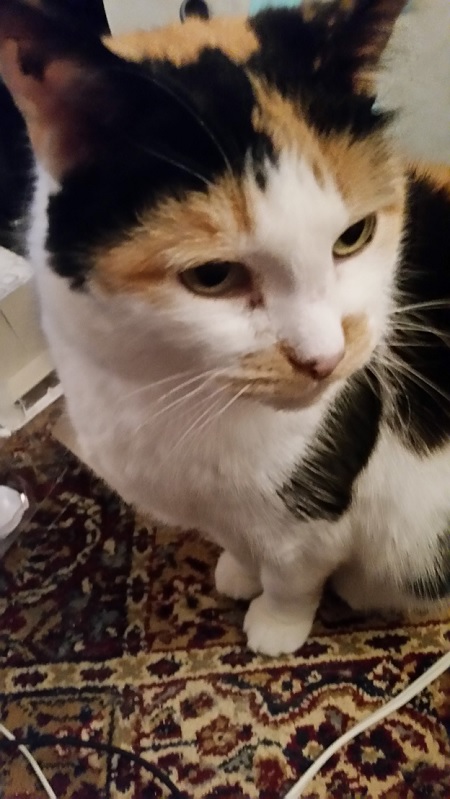
As joyous as I was to find a card with a similar name to a wonderful cat as Lucca, I wasn't really that enthusiastic for Lukka for my Cube because of how niche of a role he plays.
I've seen conversations about utilizing Lukka as part of a Cube Polymorph package, with Lukka and M21's Transmogrify; essentially decks like Sneak Attack and reanimator are all about putting a giant dork into play as soon as possible, although some don't play together all that well. Cards like Oath of Druids can clash with reanimator strategies since they utilize creatures like Putrid Imp and Wild Mongrel that dump large bodies into the graveyard, and hitting one of those with Oath of Druids might as well be a game loss. This makes these kinds of cards incredibly narrow, and in a color as laser-focused as Red, it's even more of an issue.
Usually there's only room for one non-aggro Red archetype in a Cube, because it doesn't play well with aggro cards (for the love of Purphoros, don't play Lukka in your aggro decks), whether it's Wildfire decks and other "big Red" style decks, cheatyface Red decks, etc. This is yet another angle to choose from.
Fire Prophecy - Red spells that can't go to the face are in an unusual spot, since most Red removal that doesn't hit face generally has to be incredibly flexible or powerful to make it worth playing. Cards like Abrade are much more the exception than the rule for Cube Red damage spells. Fire Prophecy adds another wrinkle by being able to push cards that aren't doing anything, but it suffers similarly with other cards mentioned above - that aggro decks generally aren't in the market for, but one that they can play in sideboarded matchups for mirrors. There's better things to spend Red spell slots on.
Flame Spill - I've liked Super-Duper Death-Ray before. It's fine for being a Red removal spell that deals with midrange beef and also isn't terrible against soldier tokens and aggro threats. Hardly necessary but wouldn't turn my nose up to it if I was in aggro.
Forbidden Friendship - there's an embarrassment of riches at two mana for aggro decks. Not really better than existing options; the days when we'd be clamoring for a 2-mana 2-power haster have long ended. Better than Dragon Fodder, though, but you can do better than that already.
Weaponize the Monsters - much like with the Zulaport Cutthroat enchantment, you know if you're in the market for this as a redundant Goblin Bombardment type of effect. Since it requires the use of mana and damage output, it's more of a way of using creatures as small burn spells rather than as using it as a way of insurance if a creature dies.
Green
Vivien, Monsters' Advocate - This Vivien has drawn inevitable comparisons to Vizier of the Menagerie but it's much more analogous to other 5-mana green things like the various Nissas, Garruks and whatnot as something that spits out 3/3s. Usually, it was making tramplers, but being able to make reach beasts was nice in matchups where it's relevant. So far, she's mainly seeing play in Green midrange decks like this from Sirfunchalot's cube:
Test Deck #3 | Cube | Sirfunchalot
- Creatures (17)
- 1 Arbor Elf
- 1 Beastbreaker of Bala Ged
- 1 Biogenic Ooze
- 1 Birds of Paradise
- 1 Boreal Druid
- 1 Elvish Mystic
- 1 Gadwick, the Wizened
- 1 Gilded Goose
- 1 Jadelight Ranger
- 1 Llanowar Elves
- 1 Lovestruck Beast
- 1 Merfolk Branchwalker
- 1 Nadir Kraken
- 1 Questing Beast
- 1 Vivien, Monsters' Advocate
- 1 Wildborn Preserver
- 1 Wolfir Avenger
- Planeswalkers (2)
- 1 Nissa, Voice of Zendikar
- 1 Oko, Thief of Crowns
- Sorceries (6)
- 1 Call of the Herd
- 1 Mouth // Feed
- 1 Banishing Light
- 1 Temporal Isolation
- 1 Utopia Sprawl
- 1 Wild Growth
- Lands (15)
- 3 Island
- 6 Forest
- 1 Misty Rainforest
- 1 Volcanic Island
- 2 Savannah
- 2 Tropical Island
Her static abilities are better than they look too, working with shuffles and being able to act somewhat like an Experimental Frenzy to chain a few creature spells together if you untap with her. Even her minus, which was only occasionally used, was nice to be able to put a ton of bodies on the table with a midrange card being cast and almost always just ended the game if it was used - the first time that I saw it used, it was to get a Questing Beast into play via casting Biogenic Ooze, resulting in the game ending shortly after.
In the limited amount of time that we've been able to play her, she's been noticeably better than Garruk, Primal Hunter, but that certainly doesn't make said Garruk bad or something that should be cut from a Cube. I've found Green midrange tends to work well when using resilient threats, and Green planeswalkers do a great job of playing to that particular strength.
Gemrazer is the best version of a mutate creature that we've seen and I really wish that more of them were like this, where it's good on its own as an on-curve threat, cheap to mutate and has a good mutate trigger that can be used proactively. It's been impressive as a good role filler like Reclamation Sage, as cards that are able to destroy artifacts (and to a lesser extent, enchantments) are valued in Cube much more than in other Constructed formats because artifacts tend to be more prominent, and playing a turn one mana elf and a turn two mutate via Gemrazer has been relatively common.
Metallix87 ran this in a sweet recent 3-0 deck in a recent deck with some m21 goodies in it as well.
Test Deck #4 | Cube | Metallix87
- Creatures (14)
- 1 Avacyn's Pilgrim
- 1 Boreal Druid
- 1 Duskwatch Recruiter
- 1 Elves of Deep Shadow
- 1 Garruk's Harbinger
- 1 Gemrazer
- 1 Growth-Chamber Guardian
- 1 Hexdrinker
- 1 Llanowar Elves
- 1 Llanowar Visionary
- 1 Noble Hierarch
- 1 Sylvan Advocate
- 1 Voracious Hydra
- 1 Wolfbriar Elemental
- Planeswalkers (5)
- 1 Basri Ket
- 1 Garruk, Primal Hunter
- 1 Garruk, Unleashed
- 1 Nissa, Vital Force
- 1 Serra the Benevolent
- Sorceries (3)
- 1 Council's Judgment
- 1 Finale of Glory
- 1 Trumpeting Herd
- Enchantments (3)
- 1 Grasp of Fate
- 1 Prison Realm
- 1 Wild Growth
- Lands (15)
- 4 Plains
- 6 Forest
- 1 Marsh Flats
- 1 Misty Rainforest
- 1 Windswept Heath
- 2 Savannah
Titanoth Rex has played well as yet another Green card that's an honorary Golgari card, that works mostly as a way to dump a large creature into the graveyard. It's relatively poor as a ramp target since it can't protect itself despite its ginormous stats. Include only if you need yet another reanimation tool.
Wilt brings to mind Amonkhet's Dissenter's Deliverance and Forsake the Worldly, the latter highlighting the issues with a lot of these kinds of cards. From my Amonkhet review:
What made Forsake the Worldly a poor Cube card is that even in spite of its flexibility, it doesn't perform its function at a mana rate that a deck is happy with - as many bells and whistles that it has, ultimately, three mana is just too much for a Disenchant effect and its cycling isn't great either.
Wilt's certainly better because it's a Naturalize on rate, at the very least and goes along with the vein of good cyclers - doing what Cube decks want to do for function. Like with other "niche" Cube cards, you'll likely know if you want another Naturalize type of card. Ultimately, I've much more liked the ones that are attached to bodies, but if you prefer the speed of ones like Nature's Claim due to how early they disrupt early-artifacts, consider this as well.
Migration Path - Explosive Vegetation gets yet another riff, and much like with Cultivate, Green decks are better suited to cheaper acceleration. This is because even with the inherent card advantage of the more expensive ramp - since Green threats generally work on that axis anyway - Green tends to work best when it's working to jump the mana curve, not trying to jump into more mana ramp. Cycling helps it not be a dead draw but honestly, you can do much, much better. Just run some mana elves. And more of them. Even more than you think.
Commander 2020
Like other Commander boxes, a lot of air with tricolor legends, reprints, and cards that only care about Commander. Still, some nice things to consider, but nothing that's a stone-cold staple.
Verge Rangers has been yet another good 3-drop for Cube, although it's more friendly for midrange and control than aggro. Buildingadeck had this recent 3-0 ![]()
![]() deck and he noted that Verge Rangers was an all-star there, usually netting a land or two during a game and working incredibly well with Blue library manipulation.
deck and he noted that Verge Rangers was an all-star there, usually netting a land or two during a game and working incredibly well with Blue library manipulation.
Although it's been a meme that Oracle of Mul Daya doesn't do much in this day and age, Verge Rangers has generally been doing the job of Oracle better, relying much less on the highrolls that Oracle usually needs to rely on to make the ![]()
![]() mana cost worth it.
mana cost worth it.
Test Deck #5 | Cube | Usman Jamil
- Creatures (8)
- 1 Blade Splicer
- 1 Brimaz, King of Oreskos
- 1 Gideon's Lawkeeper
- 1 Jace, Vryn's Prodigy
- 1 Kinjalli's Sunwing
- 1 Stalking Leonin
- 1 Student of Warfare
- 1 Verge Rangers
- Planeswalkers (5)
- 1 Elspeth, Sun's Champion
- 1 Gideon, Ally of Zendikar
- 1 Jace, the Mind Sculptor
- 1 Mu Yanling, Sky Dancer
- 1 Teferi, Hero of Dominaria
- Instants (5)
- 1 Brainstorm
- 1 Mana Leak
- 1 Miscalculation
- 1 Path to Exile
- 1 Swords to Plowshares
- Sorceries (1)
- 1 Sunlance
- Enchantments (4)
- 1 Banishing Light
- 1 Cast Out
- 1 Control Magic
- 1 Journey to Nowhere
- Lands (17)
- 6 Island
- 9 Plains
- 1 Celestial Colonnade
- 1 Hallowed Fountain
Sanctuary Blade - A common complaint that I've heard the sword of X + Y cycle is that they can make some matchups polar, like if you're on a Red deck, a Sword of War and Peace can nearly end the game on its own if equipped, and moreso if the saboteur trigger is a particularly punishing one. If you don't like this about the swords, I've found that the problem is a lot worse with Sanctuary Blade since its protection can be tailor made for the board state, which was extremely annoying for Green decks that played to the board.
There were definitely times that it ended games on its own since the opponent couldn't deal with the equipped creature then and there, and then just died. The equip cost does at least help to telegraph it, but it was still a very good card nonetheless. Overall, I've been a fan of it because I'm always wanting more good equipment for Cube, especially for aggro decks (by the way, Flayer Husk is better than you think. Captain's Claws too.) Give it a whirl if that's something you're in the market for, but if you're not a fan of the pressure that swords place on spot removal, you'll really not like Sanctuary Blade.
Slippery Bogbonder - I haven't had a lot of reps with this, but it's somewhat similar to Briarhorn and its ilk for being a combat trick in addition to having some lasting effects via putting a large creature into play and giving hexproof. Flash goes a long way to make 4+ mana creatures better in Cube, and in Green, letting you protect your other creatures is nice as well. Not as good as Green's planeswalkers, but still some solid midrange beef, if you're in the market for something that does the job better than your bog standard big mana things like Avenger of Zendikar.
Cartographer's Hawk - I'm really not sure why this doesn't have a may on its trigger since it makes it much worse for aggro decks that want to use it as a consistent damage dealer. One word, as it turns out, turns it from what could have been a Cube all-star to something that I wouldn't recommend.
Fireflux Squad, Frontier Warmonger - as time goes on, I find myself falling less and less in love with 4+ mana Red creatures, since they just aren't all that necessary for an aggro game plan, and we just seem to be getting so many of them lately. I honestly don't think these cards are bad, but I also just don't see them being all that necessary for Red aggro decks these days. In theory, Fireflux Squad plays in the same deck as Lukka, but since it's just such a bad hit for Lukka and assorted Polymorph cards, it's not something I'd recommend.
Since this is coming out so long after Ikoria, I'm honestly not sure how useful you all are going to find this review. Maybe this is just telling you what you already knew about cards that you may have been trying in your Cube already. Maybe this was just a fun read with some cat pictures in it for you to have some solace from the way things have been going these days.
I'm not really sure. But hopefully you've found something useful from this.
These are dark times, and we're a lot more stressed these days and maybe we're not able to hang out with our M:TG buddies like we used to. Hopefully, these times will pass.
Don't forget to be excellent to each other.
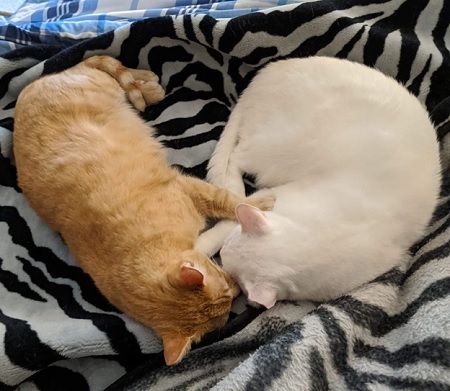
Blog, featuring my Pauper, Peasant and recently unpowered Cube list. (online list hasn't been updated to reflect this.)
The Third Power, a nearly decade-long running podcast that Anthony Avitollo and I host.
Find me on Twitter @Usmantherad. Check out these discords for Cube discussion!
















